Capturing the tastes and sounds of a New England summer, as nature intends it. After all, eating seasonally and locally is the original culture of everyone’s ancestors, long before geographic boundaries or even language.
story
Eating Locally & Seasonally
Upon entering the spacious, industrial-meets-farmhouse kitchen at Stone + Root Homestead in Middleborough, Massachusetts, we were greeted by this fabulous menu scroll representing an appropriate welcome: using what’s available to create beauty, and then share it with friends and family.
They created the menu scroll from repurposed materials found in the 1700s farmhouse they call home: the antique nails were found in the attic, the rod is an old fireplace poker, and the bottom magnet was a wall magnet for knives, which they took down when they painted the kitchen.
Similarly, as the New England seasons change, so do the meals that J & K prepare at Stone + Root, allowing the bounty of their own land and the surrounding areas drive what’s on their table. It may change, but it is always delicious.

They like to remind us that before we defined food by nationality, and long before supermarkets carried food from anywhere and everywhere, cuisine grew out of and was defined by what was available in a given location.
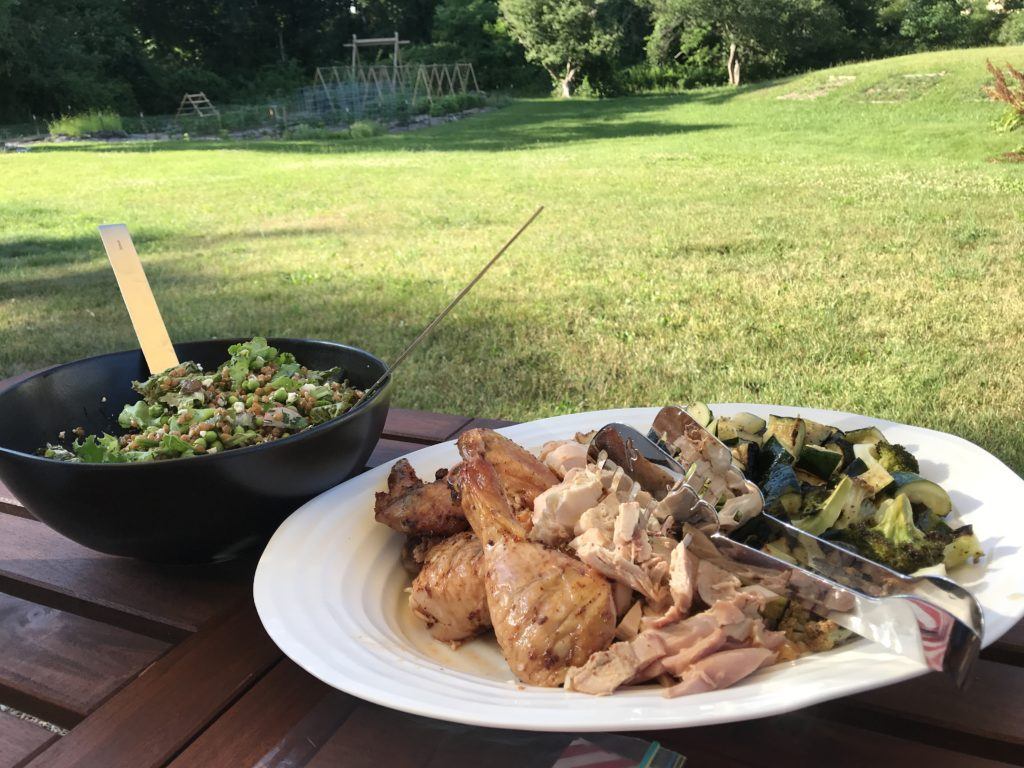
Our most recent visit to Stone + Root Homestead was in early July 2018, and the entire feast was built around what was available then. At that time, the strawberries were finishing up, a variety of peas were in overdrive, and there were plenty of cucumbers, summer squash, zucchini, broccoli, and cauliflower. The polenta (in the cake) and rye (in the crackers) were from last year’s harvest, and the chicken came from Freedom Farm in a neighboring town, Raynham.
Trying to eat seasonally might seem like a daunting task but they say it isn’t. They suggest that the easiest way to do it is by visiting a local farm or farmers market and simply buy what’s available. “The farmers are our best resource,” says J. She will let you know what will likely be available in the coming weeks and also give you some suggestions on how to prepare her offerings.
“Flexibility is important because Mother Nature always has the final say. Be willing to try to substitute ingredients. We’ve never been disappointed when we have swapped ingredients and sometimes, the new combination becomes the preferred one. I can think of a poached fish dish that called for cauliflower but the closest thing we could get were kale florets. The resulting dish was amazing and it was even better than the cauliflower version.”
J, of Stone + Root
When we eat in season, our taste buds thank us. When my kids tell me that the strawberries they begged me to buy in New York City in December don’t taste good… there’s a reason! J & K agreed: “Eating food that has been grown locally and in season is delicious! It makes cooking easy because the fresh vegetables do all of the work.” He went on to explain that in addition to tasting better, the food is more nutritious. “It tastes better because your body is saying, there are lots of nutrients in this. Give me more!”
music
Natural ‘Al Fresco’ Sounds

Staying true to celebrating what is found right around them, J & K did not have speakers blasting music into the backyard. Instead, they let the sounds of nature flood our ears. Breezes through the trees, birds, cicadas, and the occasional tractor roaring by.
Only after weeks had past did I realize we should have recorded the actual sounds that evening to complete this portrait. By then, the Carolina warbler had moved on, and the soundscape was different, so we vowed to capture it the first week of July 2019. In the meantime, we gathered appropriate nature sounds on a free Spotify playlist.
A 2019 update: We reconvened at Stone + Root on another early July evening for another spectacular dinner al fresco, and this time we recorded actual birdsongs. It had to be early July again because that’s when the Carolina warbler is in town. Here is a taste:
Over the course of our evening we enjoyed so many brushes with nature from the family of turkeys pictured below, to bunnies, to shed cicada exoskeletons. We can not wait to go back!

recipe
Plan Ahead
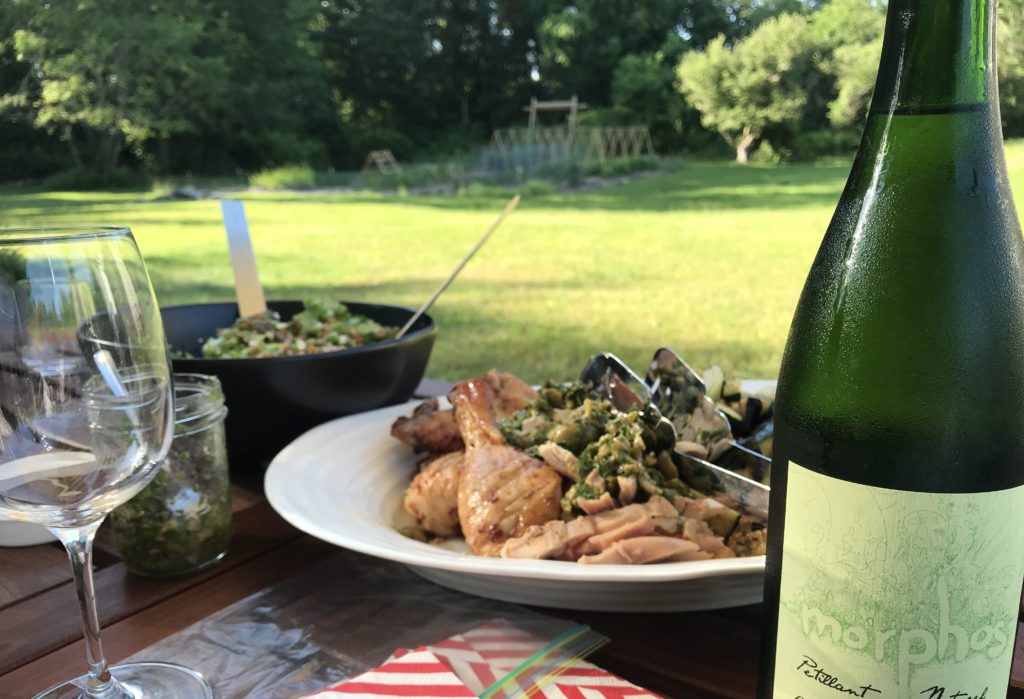
Note: to replicate the entire menu, you will need some advance preparation.
- Plan to spatchcock and season the chicken the night before for best results (at least 8 hours prior and up to 2 days).
- The Rye Crackers can be made quite in advance since they keep well, and it’s always nice to have one less thing to do on the day of hosting.
recipe
Drinks
Fitting with the theme, the drinks were also local. Of course, this section should be adapted to what’s local for you, but for inspiration, here’s what we enjoyed.

With the appetizers, we taste-tested two growlers from IndieFerm (aka Independent Fermentations). The Rye and Sage Saison was our favorite.
With dinner, we had a lovely white wine (Morphos Petillant Naturel 2016) from Oyster River Winegrowers – a dry, bubbly white with light orchard fruits and good acidity.


While having Kate’s “Farewell to Strawberries” polenta cake, we enjoyed Rose from Bedell Cellars on Long Island. As the description claims, it was rich but dry berry/cherry, which made it a perfect pair for the berried polenta cake.
recipe
Pea Dip

Pea Dip
Ingredients
- Fresh peas
- Herbs of choice: dill, mint, basil.
- Yogurt
- Salt
- Your choice of veggies and crackers to scoop the dip
Instructions
- Wash/shuck the fresh peas from their pod and put in a food processor. (If the peas are not super fresh, blanch them for 45 seconds to freshen them up and soften some of the starchiness that can develop after harvest.)
- Wash your herbs and add to the food processor.
- Add yogurt and salt to the food processor and pulse until combined. Keep refrigerated until ready to serve.
- Meanwhile, prepare the vehicles: for early July in Massachusetts, this meant cucumbers, snap peas, kohlrabi, and homemade rye crackers.
recipe
Rye Crackers
K is well known for her cooking, especially her baking which extends from sweets to satisfying and delicious crackers like these.
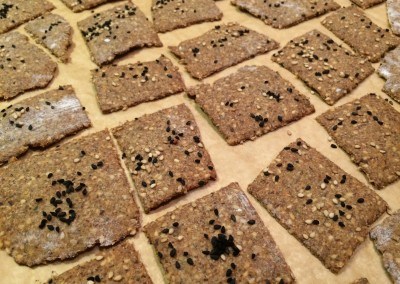
Rye Crackers
Ingredients
- 1/4 cup sunflower seeds (35g)
- 1/4 cup pepitas (40g)
- 3 tbsp flaxseed (20g)
- 3/4 cup whole wheat flour (105g)
- 1 cup rye flour (120g)
- 6 tbsp sesame seeds (50g)
- 1-2 tbsp nigella seeds (optional)
- 1/3 tsp kosher salt
- 2 tbsp olive oil
- 1 tbsp honey
- 3/4 cup water
Instructions
- Heat oven to 300°F. Line a baking sheet(s) with parchment paper.
- In a spice grinder, pulse the sunflower seeds and pepitas to a fine powder. Transfer to a large bowl. Pulse flaxseed to a fine powder and add to the bowl. Add the flours, whole sesame seeds, nigella seeds, salt, oil, honey, and water. Stir with a wooden spoon for 1-2 minutes to form a firm, unsticky ball.
- Transfer dough to a floured surface and knead briefly to make sure it holds together and ingredients are distributed. It will feel slightly tacky but not sticky.
- Divide dough into four pieces. On a well-floured surface, roll out dough until it is relatively thin (1/16 of an inch). Check dough while rolling to be sure it is not sticking to the surface.
- Using knife or dough scraper, cut dough into crackers of your preferred size and shape. Transfer crackers to prepared baking sheets. (Crackers won’t spread, so they can be very close.)
- Bake for 25-35 minutes (rotating pans halfway through if doing 2 at once), until crackers are golden brown and seem well-dried and crisp. Remove from oven and let sit on baking sheet to crisp up more, about 5-10 minutes.
Notes
recipe
Wheat Berry & Pea Salad
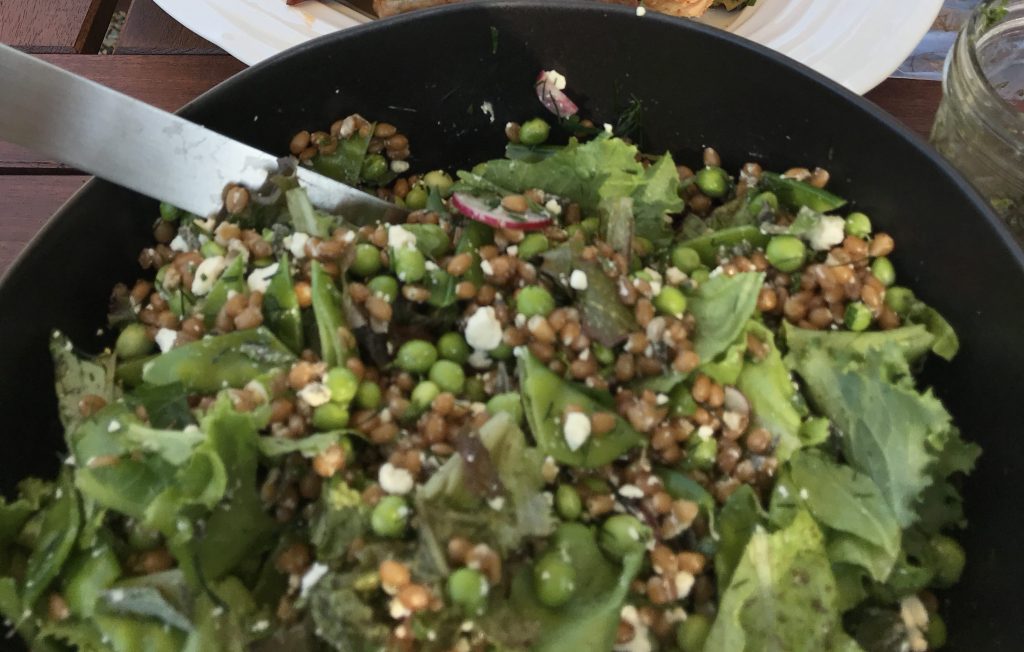
Wheat Berry & Pea Salad
Ingredients
- 1 cup wheat berries
- 2 cups of a combination of peas, snap peas, snow peas, sliced and then blanched (6 oz)
- 1 clove garlic, minced
- 1 tbsp lemon juice
- 1 tsp balsamic vinegar
- 3 tbsp olive oil
- salt (to taste)
- pepper (to taste)
- 1 mix of fresh greens, washed
- ricotta salata, crumbled
- 1/3 cup mint leaves, torn
Instructions
- Add wheat berries to boiling water and boil for 35–45 minutes until wheat berries are plump with the texture of al dente pasta.
- Blanch the peas.
- To make dressing: combine garlic, lemon juice, vinegar and olive oil. Add salt and pepper to taste.
- Put the greens in a large serving bowl, and add the wheat berries and peas when cooled.
- Before serving, add cheese and mint to bowl, then add the dressing and toss well. Season with additional salt and pepper to taste.
recipe
Spatchcocked and Herbed Grilled Chicken with Crushed Olives
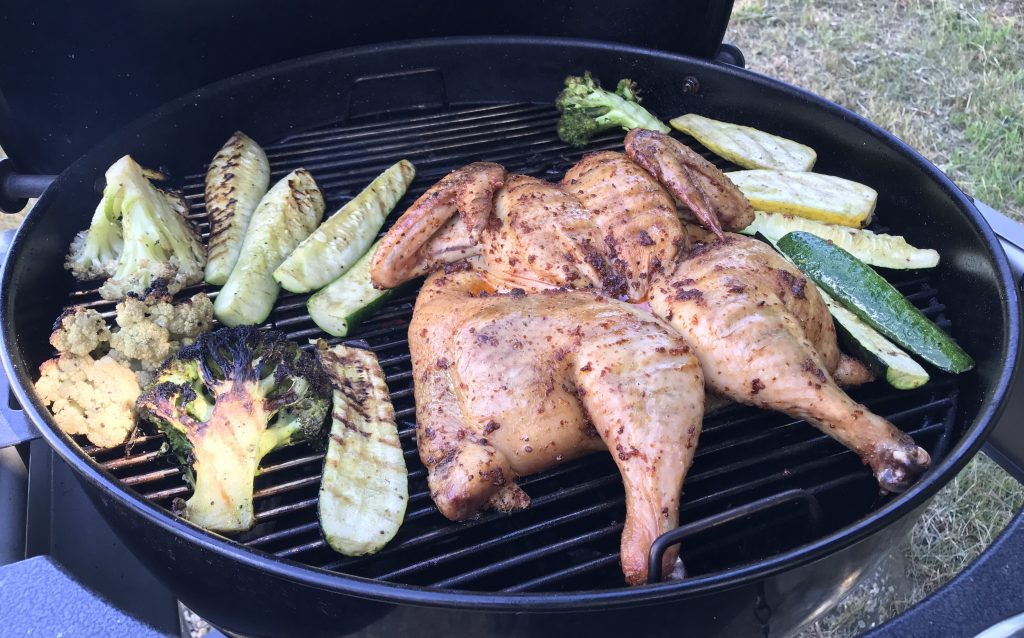
Spatchcocked and Herbed Grilled Chicken with Crushed Olives
Ingredients
- 1 3 1/2-4 lb chicken, backbones removed
- Kosher salt
- freshly ground pepper
- 3 cloves garlic, finely grated
- 2 tbsp Aleppo-style pepper
- 2 tbsp finely chopped rosemary
- ½ cup olive oil, divided
- ½ cup Castelvetrano or other green olives, pitted, torn
- 2 tbsp fresh lemon juice
- 2 tbsp chopped oregano
- ¼ cup chopped parsley, plus leaves for serving
Instructions
- At least 8 hours before you plan to cook the chicken (or better yet, a day or 2 before) spatchcock your chickens per this great tutorial on Bon Appetit (link in notes below). Season generously on all sides with salt and black pepper and keep in the refrigerator, uncovered, up to 2 days.
- Leave the chicken on the counter for 1-2 hours to allow the chicken to come to room temperature before cooking. Immediately combine garlic, Aleppo pepper, rosemary, and ¼ cup oil in a small bowl and rub it all over the chicken.
- Prepare a grill to have two heat zones: medium-high and indirect heat. Charcoal grills should have coals banked to one side, and for a gas grill, one or two burners can be left off.
- Once hot, oil the grate over the indirect heat and set chickens, skin side down. Cover grill. If your grill has a vent, positioning the vent above the chicken draws the heat up and over the chicken for better cooking. Cook 15-20 minutes or until skins are lightly browned, rotating the chicken as needed to color evenly.
- Turn chickens and continue to cook, covered, for around 20–25 more minutes until skins are deep golden brown and crisp and an instant-read thermometer inserted into the thickest part of breasts registers 160°F. Transfer chickens to a cutting board and let it rest at least 10 minutes before carving.
- Mix olives, lemon juice, oregano, chopped parsley, remaining ¼ cup oil, and any accumulated juices from chicken on the cutting board in a medium bowl. Season with salt.
- To serve, arrange carved chickens on a platter and top with olive mixture and parsley leaves.
Notes
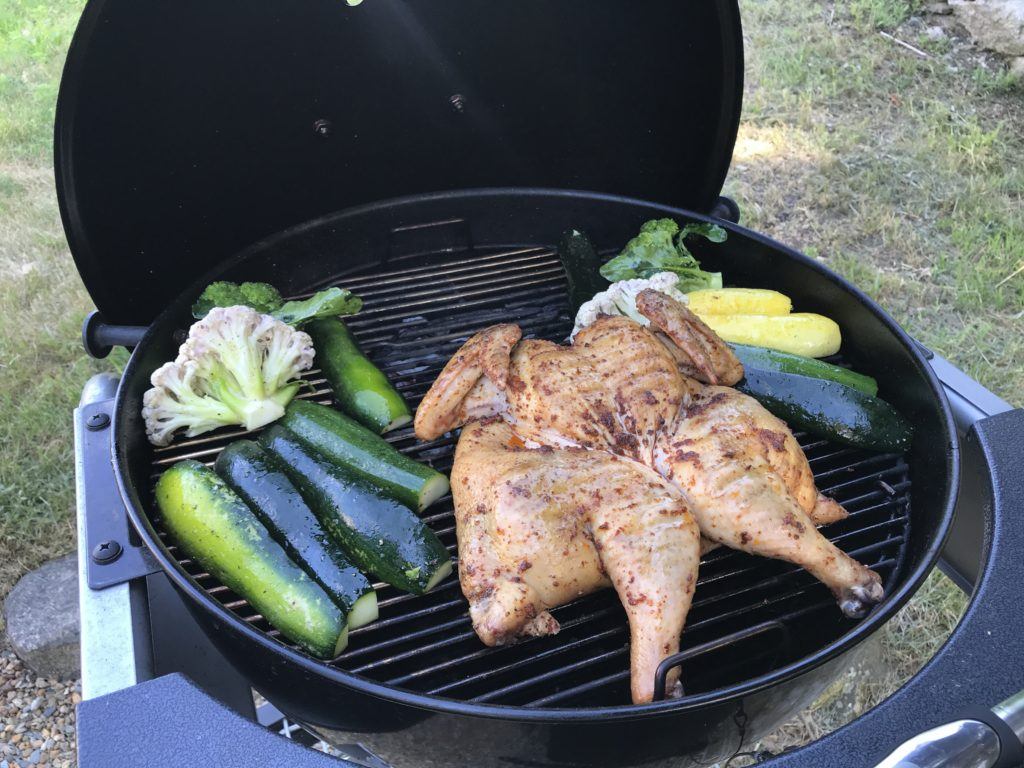
recipe
Grilled Seasonal Veggies
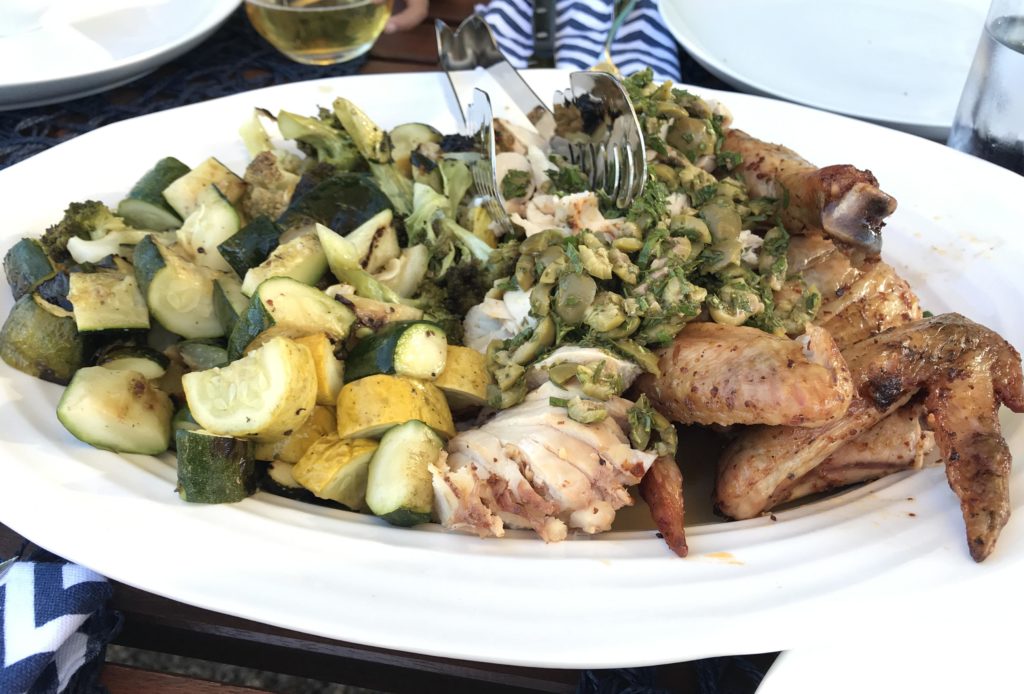
Grilled Seasonal Veggies
Ingredients
- in-season local veggies
- olive oil (enough to lightly cover cut veggies, and some to brush on the grill grates)
- salt
Instructions
- Wash and slice vegetables in a way that they a) don’t slip through the cracks of the grill and b) cook at relatively similar speeds. Per the photo of the chicken and veggies on the grill, that means spears or thin slices of zucchini and summer squash and chunks or thick slices of broccoli and cauliflower.
- Place veggies in a large bowl and keep ready until just before ready to grill. Then toss with olive oil and salt until sufficiently covered, and add to the grill along with the chicken.
- Watch carefully, flipping when cooked to your desired doneness.
recipe
Strawberry Polenta Cake with Mixed Berries
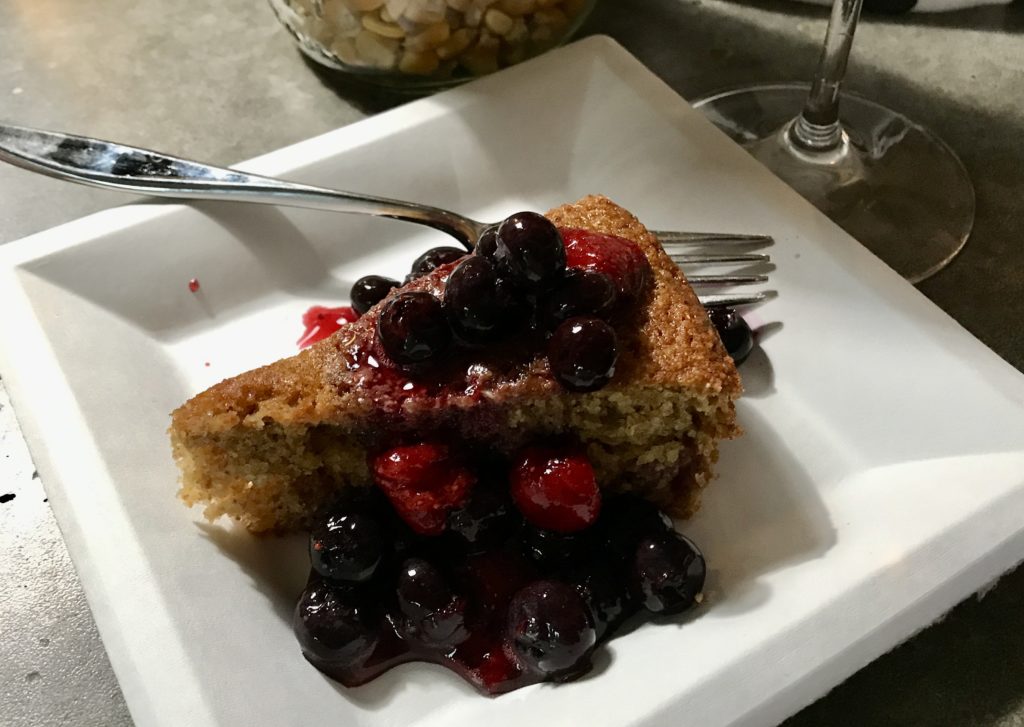
Strawberry Polenta Cake with Mixed Berries
Ingredients
- 50 g almond meal (about 1/2 cup)
- 90 g fine polenta (about 1/2 cup)
- 70 g whole wheat flour (about 1/2 cup)
- 1 tsp baking powder
- 1 pinch salt
- 3 eggs
- ½ cup olive oil
- 100 g sugar (about 1/2 cup)
- zest of 1 lemon
Berry Topping
- Your choice of seasonal fresh berries, cut up if needed (strawberries, blueberrries, raspberries…)
- A little sugar, honey, or maple syrup
Instructions
- Heat oven to 350°F.
- Oil cake pan and line bottom with parchment paper (or oil muffin tin for small cakes).
- In a small bowl, combine almond meal, polenta, flour, baking powder, and salt.
- In a separate bowl, beat the eggs and olive oil until you have a creamy emulsion. Add the sugar and lemon zest.
- Fold the dry ingredients into the wet mixture and pour the batter into the prepared pan. Arrange strawberries on top. Bake for 20-25 minutes or until tester comes out clean and the cake is golden and springy to the touch.
- For topping, mix berries with a little sweetener (sugar, honey, or maple syrup). The amount will depend on the amount of berries and their sweetness. Let sit out, or put in refrigerator for later.
- Serve sliced and topped with fresh berries.
Notes
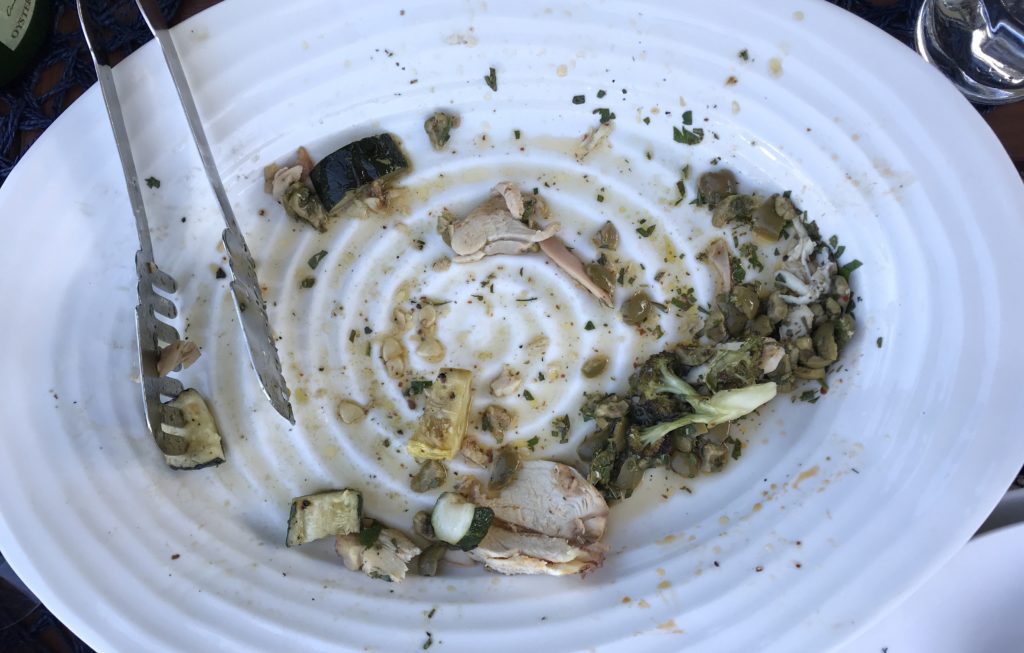
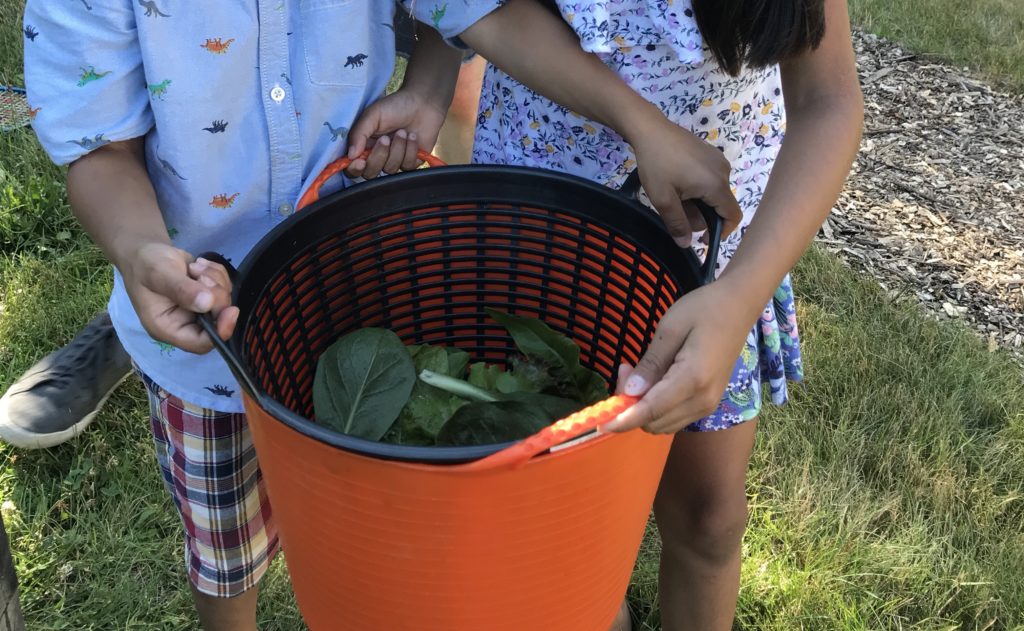
Still with us? Here’s a bonus: do you know the origins of the unusual word “spatchcocked?” It’s not entirely certain but it is believed to be a version of spitchcocked (“to split and broil an eel”) and likely a corruption of dispatch and cock.
And with that… over and out!